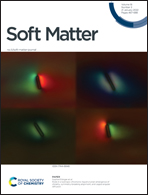Shear-induced migration of confined flexible fibers†
Abstract
We report an experimental study of the shear-induced migration of flexible fibers in suspensions confined between two parallel plates. Non-Brownian fiber suspensions are imaged in a rheo-microscopy setup, where the top and the bottom plates counter-rotate and create a Couette flow. Initially, the fibers are near the bottom plate due to sedimentation. Under shear, the fibers move with the flow and migrate towards the center plane between the two walls. Statistical properties of the fibers, such as the mean values of the positions, orientations, and end-to-end lengths of the fibers, are used to characterize the behaviors of the fibers. A dimensionless parameter Λeff, which compares the hydrodynamic shear stress and the fiber stiffness, is used to analyze the effective flexibility of the fibers. The observations show that the fibers that are more likely to bend exhibit faster migration. As Λeff increases (softer fibers and stronger shear stresses), the fibers tend to align in the flow direction and the motions of the fibers transition from tumbling and rolling to bending. The bending fibers drift away from the walls to the center plane. Further increasing Λeff leads to more coiled fiber shapes, and the bending is more frequent and with larger magnitudes, which leads to more rapid migration towards the center. Different behaviors of the fibers are quantified with Λeff, and the structures and the dynamics of the fibers are correlated with the migration.



 Please wait while we load your content...
Please wait while we load your content...
